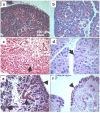Early markers of regeneration following ductal ligation in rat submandibular gland
- PMID: 18335244
- PMCID: PMC2493059
- DOI: 10.1007/s00441-008-0588-6
Early markers of regeneration following ductal ligation in rat submandibular gland
Abstract
Rat submandibular glands can recover their function and secretory protein content following ductal ligation-induced atrophy. Morphological studies have established that following ligation, deligation of the gland allows the regeneration of new salivary gland tissue. However, little is known about changes happening during early regeneration following intra-oral duct ligation, which does not damage the parasympathetic nerves. Glands that had been 2 weeks ligated or 2 weeks ligated + 3 days deligated were compared. Tissue was prepared for histological, immunohistochemical (SMG-B and Ki-67) and immunocytochemical analyses (smooth muscle actin, aquaporin 5). Haematoxylin and eosin staining of deligated glands showed that some acini regained their cytoplasmic volume; moreover, the loss of Alcian blue/periodic acid-Schiff's staining from the lumen of ducts suggested successful deligation. The deligated gland was characterized by atypical acinar-ductal branched structures, which were less frequent in the ligated gland and rarely seen in normal unoperated tissue. Myoepithelial cells were also investigated since changes in their morphology reflected changes in the acini morphology not readily detected by conventional staining. Actin staining revealed the presence of some shrunken acini in the atrophic tissue, whereas they had regained their normal morphology in the deligated gland suggesting that the acini were recovering. Some acini during deligation regained aquaporin 5 expression, which had decreased during atrophy. SMG-B protein, located in the pro-acinar cell during gland development and usually found in the intercalated duct cells in the adult, was detected in the newly formed acini of the deligated gland. This study suggests that morphological markers of regeneration appear as early as 3 days following ligation removal.
Figures








References
-
- Ball WD, Hand AR, Johnson AO. Secretory proteins as markers for cellular phenotypes in rat salivary glands. Dev Biol. 1988;125:265–279. - PubMed
-
- Ball WD, Hand AR, Moreira JE. A neonatal secretory protein associated with secretion granule membranes in developing rat salivary glands. J Histochem Cytochem. 1991;39:1693–1706. - PubMed
-
- Burgess K, Dardick I, Cummins MM, Burford-Mason AP, Basset R, Brown DH. Myoepithelial cells actively proliferate during atrophy of rat parotid gland. Radiol Endod. 1986;82:674–680. - PubMed
Publication types
MeSH terms
Substances
Grants and funding
LinkOut - more resources
Full Text Sources

